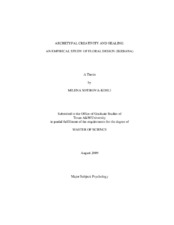| dc.description.abstract | The theory of embodied cognition focuses on mechanisms of meaning beyond
the traditional in western metaphysics dichotomy of body and mind. These mechanisms
are considered to be the emerging aspects of meaning related to early infant experience
of interaction with the environment. Image schema as the earliest form of representation
in the mind corresponds to the notion of archetype from analytical psychology. Theory
and research suggest that being in touch with the archetypal level of cognition is related
to integration of parts of the personality and promotes well-being. Art and creativity are
considered to facilitate this process and in this sense to promote healing. Active
imagination is a method devised by C. G. Jung to relate to different aspects of the
personality through creativity which results in a creative product. Active imagination
bears similarity to art, however it focuses not only on the aesthetic outcome of the
creative endeavor but also on the transformation of the personality in this process.
Analytical psychology studies a number of creative expressions of the products of active
imagination such as sand play, drawing, clay modeling, writing, dancing and
psychodrama. However, there are no available empirical studies of the healing aspects of creative work with cut flowers. We hypothesized that being involved in creative work
with cut flowers would promote well -being expressed in increase of hope,
existential/spiritual meaning and humility and decrease of depression, anxiety and
physiological symptoms. The participants in our study were undergraduate students from
Texas A&M University either involved in a semester long course in Floral Design or in
an Introductory Psychology Course. Participants were assessed at two time points on all
variables of interest. They were also asked to draw mandalas and to write essays (floral
condition). Although quantitative analysis did not find any significant differences
between the groups over time as a result of the creative work with cut flowers, the
qualitative analysis of the mandala-drawings and the essays showed statistically
significant tendency to balance, centeredness and calmness over time in the floral group. | en |


